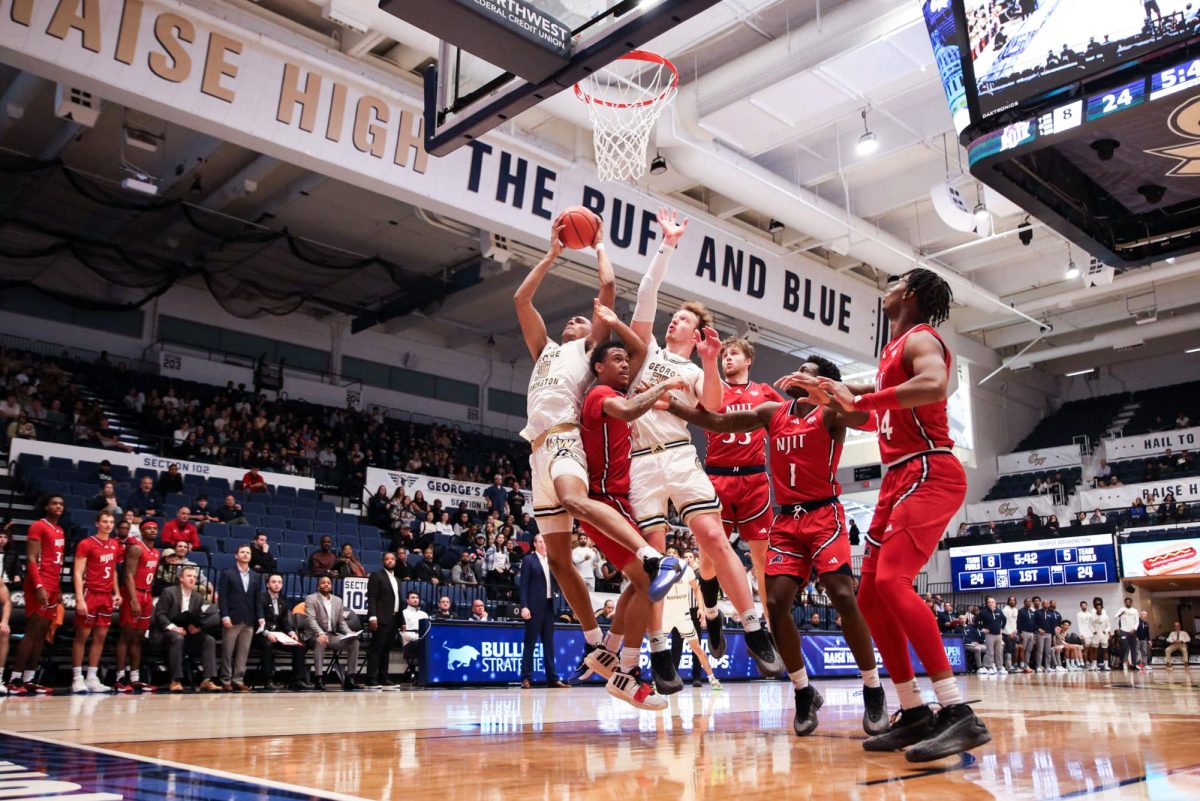At 22nd and G streets, the Smith Center is a serviceable albeit antiquated home to several GW sports teams. But with a seating capacity of just 5,000 people, the arena is an equipment shed compared to the facilities at nearby University of Maryland.
In fall 2002, the $108 million Comcast Center became the Terrapins’ immaculate new home for men’s and women’s basketball, seating nearly 18,000 people and accommodating more cars than the Smith Center can fit fans.
So what effect does money have on the success of the teams that play in these buildings? None, according to a recent NCAA report.
In a two-year study released last month, the NCAA found that increased spending on athletics does not lead to more wins, nor does it lead to greater revenue.
But GW officials and coaches said the size of a school’s athletic budget can impact the success of the program indirectly. GW’s athletic budget of around $11 million, which is set to be slashed by just under 10 percent in the upcoming fiscal year, falls in the middle range of both Atlantic 10 and Division I schools.
GW Director of Athletics Jack Kvancz said athletic spending can be broken down into money for coaches, money for teams and facilities. He added that the size of GW’s budget, particularly with regard to the two latter aspects, ultimately limits how successful the Colonials can be.
“Every program, I don’t care who it is, gets to a certain point, and to get over that hump is really, really hard to do,” he said. “And that’s when facilities come in.”
Kvancz also said he agrees with the findings of the NCAA report, “but money might keep your coaches, so indirectly it matters. Then again, there is no guarantee that the coach will make you better either.”
According to a report GW filed with the federal government, which dates back to the 2001-02 academic year, the University’s average salary for head coaches is more than $43,000, good for fourth best in the A-10. But some coaches said the high cost of living in Washington deflates the relative value of their salaries.
“(The Washington area) is an expensive place to live if you have to buy a home here and raise a family,” said women’s basketball head coach Joe McKeown. “That’s the one difference between being a student here and working at the University, and I think that makes it tough on a lot of coaches.”
Former softball head coach Leslie Moore said after her resignation in June that she was one of those coaches. Kvancz said losing coaches to schools that offer higher salaries is always a concern but is, to a certain degree, inevitable.
“I’m concerned about losing good coaches, but I’m also happy that people leave for the most part with a good taste in their mouth, because that makes it easier for me to get a new coach,” he said. “But you’re going to have a situation where a (former men’s basketball coach) Mike Jarvis or a (former women’s crew coach) Steve Peterson leaves for twice the money, and I can’t control that.”
By and large, however, coaching salaries at GW are competitive enough to keep good coaches. In many cases, it is the disparity in team operating budgets between GW and its wealthier counterparts that keeps the University from being an elite sports school.
Golf Coach Scott Allen said his team is adequately funded but limited in the amount of money it can spend pursuing recruits and paying for their full tuition.
“It makes a huge difference, especially at GW, where tuition is $40,000 a year and there are limited scholarship funds,” he said. “I can’t get a kid if he’s looking at Maryland and GW. It’s almost impossible. It keeps us from being an elite program.”
In addition to recruiting, scheduling becomes a financial issue in big-money sports such as basketball. While the GW women will host some of the top teams in the country, students looking for top-ranked men’s teams in the Smith Center this winter will have to settle for the likes of Towson and Florida International University before A-10 play begins.
“When you look at schools with bigger budgets, they are able to buy home games and pay schools thirty or forty thousand dollars,” men’s basketball head coach Karl Hobbs said. “And that’s something that we can’t do.”
Without that money to spend, and without the winning reputation that the GW women use to lure teams to Foggy Bottom, the Colonial men have had a hard time getting big-name opponents at home in recent years. It is typical for teams to play each other in back-to-back seasons, with each getting a home game, but Hobbs said top teams have asked for more than that.
“It makes it more difficult to play against schools that you can probably beat,” he said. “Scheduling is very difficult for a lot of different reasons, but for us, trying to get a home-and-home against top-caliber teams, a lot of times they’ll want us to come there twice. They’ll want to do a two-for-one.”
But while differences in athletic funding can affect teams indirectly, McKeown pointed to the consistent success of his teams with a mid-size budget as proof that money is not the bottom line in college sports.
“You could make a case that college athletics is a big arms race,” he said. “A lot of schools are putting a lot of money into athletics, building new buildings, etc. But we’re still able to compete.”
Money certainly wasn’t a factor, McKeown added, when his Colonials beat the University of Oklahoma on the Sooners’ home court in the first round of the 2003 NCAA Tournament. Oklahoma’s athletic budget is nearly four times bigger than GW’s.
“If you would have seen just their practice facilities, you’d probably sign with them,” he said. “I mean their locker room looked like a health spa. But we still beat them on their home court. So we can’t worry about those things. We’re who we are.”
But Kvancz said GW as a whole will never be able to compete with schools like Oklahoma so long as the financial disparity exists.
“Can you compete with them in a sport? Yes. Can we compete with them in 22 sports? No,” he said.
He added, “That being said, we’re pretty good, but we’re going to hit a glass ceiling. And the better the coach, the harder they work, the sooner you’re going to hit that glass ceiling.”






